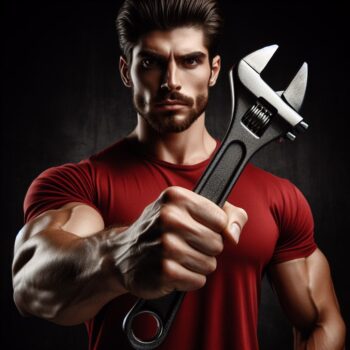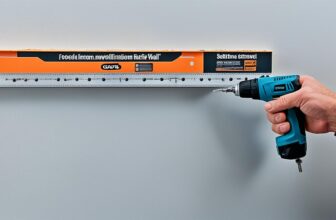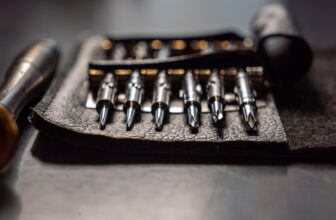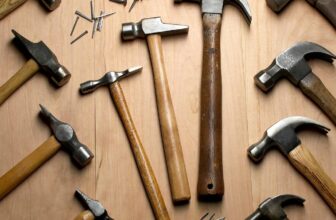Wrenches are indispensable tools in the field of mechanics, allowing professionals and DIY enthusiasts to efficiently loosen or tighten nuts, bolts, and other fasteners. However, with the wide variety of wrenches available, it can be challenging to determine which type is best suited for specific tasks. In this comprehensive guide, we will explore the different types of wrenches, their functionalities, and their applications, enabling you to enhance your mechanical skills and make informed choices when selecting the right tool for the job.
Key Takeaways:
- Understanding the various types of wrenches available can enhance your efficiency and effectiveness in mechanical work.
- Different wrenches serve different purposes, and the right tool for the job is crucial.
- Common types of wrenches include adjustable wrenches, socket wrenches, combination wrenches, and torque wrenches.
- Specialty wrenches such as crowfoot wrenches, tap wrenches, and strap wrenches cater to specific tasks and challenges.
- Proper maintenance and care can extend the lifespan and usability of your wrenches.
Table of Contents
Integral Roles of Wrenches in Mechanical Work
Wrenches play integral roles in mechanical work as they facilitate the gripping and turning of objects such as nuts, bolts, and fittings. The functionality and importance of wrenches lie in their ability to provide leverage and apply torque, thereby enabling the loosening or tightening of fasteners. Understanding the design and leveraging of wrenches is crucial for maximizing their effectiveness in various mechanical tasks.
Defining Wrench Functionality and Importance
Wrenches are fundamental tools in the field of mechanics, offering a simple yet effective solution for fastening and unfastening objects. They possess several important functions:
Disclaimer:
Our recommendations are based on extensive experience with and/or knowledge of these products, and we do so not because of the modest commissions we could earn but rather because we believe they are actually beneficial and useful. We are honored to be these tools' affiliates. We might receive commissions from Amazon, and other merchants when you buy something after clicking one of our links. Our affiliate policy is covered in more detail here. If you don't think these things will help you accomplish your goals, please don't spend any money on them.
- Providing grip: Wrenches are designed with jaws or heads that securely grip various fasteners, allowing for controlled rotation.
- Applying torque: Under their leverage, wrenches allow the application of torque, which is essential for tightening or loosening fasteners with the required force.
- Transferring force: Wrenches efficiently transfer force from the user’s hand to the fastener, ensuring a reliable and effective connection.
Wrenches are crucial tools for mechanics, enabling them to perform their work efficiently and accurately. Using the right wrench for each task is essential to ensure proper fastening, prevent damage to components, and maintain the overall integrity of mechanical systems.
Understanding Wrench Design and Leveraging
The design of wrenches is carefully crafted to optimize their functionality and leverage. Key design elements include:
- Jaw shape and size: Wrenches come in various shapes and sizes to accommodate different types and sizes of fasteners, ranging from hexagonal nuts to square bolt heads.
- Handle length: The length of the handle determines the leverage or mechanical advantage of the wrench. Longer handles provide greater leverage for applying higher torque.
- Material and construction: Wrenches are typically made from durable materials such as steel or alloy, ensuring strength and longevity. High-quality construction enhances their reliability and performance.
By understanding the design principles behind wrenches, mechanics can make informed decisions when selecting the appropriate tool for each task. Leveraging the optimal design features of a wrench allows for efficient force application, minimizing the effort required and maximizing the output.
In the next section, we will explore the different types of wrenches available in the market, each tailored to specific applications and scenarios.
Types of Wrenches
In this section, we will explore the different types of wrenches available in the market. There is a wide variety of wrenches, each designed to fulfill specific purposes and accommodate different applications. By familiarizing ourselves with the various types of wrenches, we can make informed choices when selecting the right tool for the job.
When it comes to wrenches, there is no one-size-fits-all solution. Different tasks require different types of wrenches to ensure optimal performance. Let’s take a closer look at some common types of wrenches:
- Adjustable Wrench: Also known as a crescent wrench, this versatile tool features an adjustable jaw that can accommodate a wide range of fastener sizes.
- Socket Wrench: Preferred by mechanics, socket wrenches have a socket-like head that fits over fasteners, providing a secure grip and allowing for quick tightening or loosening.
- Combination Wrench: With an open-end wrench on one side and a closed-end wrench on the other, combination wrenches offer flexibility in tackling different sizes of nuts and bolts.
- Torque Wrench: Designed for precise torque application, torque wrenches enable precise tightening of fasteners, preventing under or over-tightening that could cause damage.
- Open-End Wrench: Featuring U-shaped ends, open-end wrenches are suitable for accessing fasteners in tight spaces and can be flipped to accommodate different sizes.
- Box-End Wrench: With a closed, box-like head, box-end wrenches provide high torque and are ideal for heavy-duty applications.
- Ratcheting Wrench: Ratcheting wrenches feature a mechanism that allows for continuous turning in one direction, making them useful in tight spaces where limited movement is possible.
These are just a few examples of the many types of wrenches available. Each type has its unique features and advantages, making them suitable for specific tasks. By understanding the different types of wrenches and their capabilities, mechanics can ensure they have the right tools for every job, improving efficiency and achieving optimal results.
Open-End Wrenches: Utility and Limitations
Open-end wrenches are widely used in the field of mechanics due to their versatility and ease of use. These wrenches have a U-shaped opening with two parallel jaws that are used to grip and turn nuts, bolts, and other fasteners. In this section, we will explore the basics of using open-end wrenches and discuss the scenarios in which they excel.
The Basics of Using Open-End Wrenches
Using open-end wrenches is straightforward. Here are the basic steps:
- Select the appropriate size of open-end wrench that matches the nut or bolt you will be working with.
- Slide the wrench onto the fastener, ensuring that both jaws of the wrench make contact with the flat sides of the fastener.
- Hold the wrench in place and apply force to turn the fastener either clockwise (to tighten) or counterclockwise (to loosen).
- Repeat the process until the desired level of tightness or looseness is achieved.
When using open-end wrenches, it is important to note that the wrench only grips two sides of the fastener. This can result in less contact area compared to other types of wrenches. As a result, open-end wrenches may be more prone to slipping or rounding off the corners of the fastener. Therefore, it is crucial to ensure a secure fit between the wrench and the fastener to prevent slippage and potential damage.
Scenarios Where Open-End Wrenches Excel
Open-end wrenches are best suited for certain scenarios where their unique features make them the ideal choice. Some examples include:
- Tight spaces: Open-end wrenches are often used in tight spaces where clearance may be limited. Their slim design and open jaws allow for easy access to fasteners in confined areas.
- Soft fasteners: Open-end wrenches are less likely to cause damage to soft or fragile materials compared to wrenches with teeth or gripping mechanisms.
- Non-standard fastener shapes: Open-end wrenches can be used on fasteners with non-standard shapes or odd angles, making them versatile in unique situations.
However, it is important to consider the limitations of open-end wrenches when selecting the appropriate tool for a specific task. These limitations include:
- Lack of grip: Open-end wrenches may not provide as secure of a grip as other wrench types, which can result in slippage and potential rounding off of fastener corners.
- Torque application: Open-end wrenches may not be the best choice for high-torque applications. The limited surface contact with the fastener may hinder the wrench’s ability to handle heavy loads.
- Non-adjustable: Unlike adjustable wrenches, open-end wrenches only have fixed sizes. This limits their versatility when working with fasteners of different sizes.
By understanding the basics of using open-end wrenches and the scenarios in which they excel, mechanics and DIY enthusiasts can make informed decisions when selecting the appropriate tool for their specific needs.
The Versatility of Combination Wrenches
Combination wrenches are versatile tools that offer the best of both worlds. With an open-end wrench on one end and a closed-end wrench on the other, combination wrenches provide flexibility in tackling different sizes of nuts and bolts. The open end is ideal for quick adjustments, while the closed end provides a snug fit for applying more torque. This dual-ended design allows mechanics to efficiently switch between tasks without the need for multiple wrenches.
Combination wrenches are a staple in any mechanic’s toolbox due to their ability to handle various applications. Whether you’re working on automotive repairs, plumbing installations, or machinery maintenance, having a set of combination wrenches ensures you have the right tool for the job.
Adjustable Wrenches: An Overview of Crescent Tools
Adjustable wrenches, commonly known as crescent wrenches, are versatile tools that offer the advantage of adjustable jaws. These jaws can be easily adjusted to fit a range of fastener sizes, providing flexibility and convenience. Crescent tools are widely used in various mechanical tasks due to their adaptability and ease of use.
Unique Features of Adjustable Wrenches
One of the unique features of adjustable wrenches is their adjustable jaw capacity. This means that a single adjustable wrench can be used for a wide range of nut and bolt sizes, eliminating the need to carry multiple wrenches. This versatility makes adjustable wrenches a valuable addition to any toolkit.
Furthermore, adjustable wrenches are designed with a knurled adjustment mechanism that allows for easy and precise jaw adjustment. This feature ensures a secure grip on fasteners, reducing the risk of slippage and potential damage.
Another notable feature of adjustable wrenches is their durability. These wrenches are often made from high-quality materials such as chrome-vanadium steel, which enhances their strength and longevity. The robust construction of adjustable wrenches enables them to withstand heavy use and withstand the demands of various mechanical applications.
When to Use an Adjustable Wrench
Adjustable wrenches are suitable for various tasks in different industries, including automotive repair, plumbing, and general household maintenance. Here are some scenarios where adjustable wrenches excel:
- Tightening or loosening fasteners with different sizes
- Working in tight spaces where a regular wrench cannot fit
- Emergencies where the exact size of the fastener is unknown
- Temporary repairs or adjustments
- General-purpose applications where versatility is crucial
These are just a few examples of when adjustable wrenches can be the most suitable choice. The adjustable nature of these wrenches allows for quick and efficient adjustments to match the specific requirements of each task.
The Mechanics’ Choice: Socket Wrenches Explained
When it comes to selecting the right tool for the job, mechanics often turn to socket wrenches. These versatile tools are highly favored for their efficiency and effectiveness in various mechanical tasks. In this section, we will explore the features and applications of socket wrenches, shedding light on why they are the preferred choice for many professionals.
Socket wrenches consist of a handle and a detachable socket that can fit over fasteners such as nuts and bolts. The socket is designed with a hexagonal opening that matches the shape of the fastener, ensuring a secure grip and minimizing the risk of slippage.
One of the key advantages of socket wrenches is their ability to accommodate different sizes and shapes of fasteners. With a set of sockets available in various sizes, mechanics can easily tackle a wide range of tasks without needing multiple wrenches. This versatility makes socket wrenches a valuable addition to any mechanic’s toolkit.
Another feature that sets socket wrenches apart is the use of a ratcheting mechanism. This mechanism allows for continuous rotation of the fastener without the need to remove and reposition the wrench with each turn. The ratcheting action makes socket wrenches particularly efficient, saving time and effort during repetitive tasks.
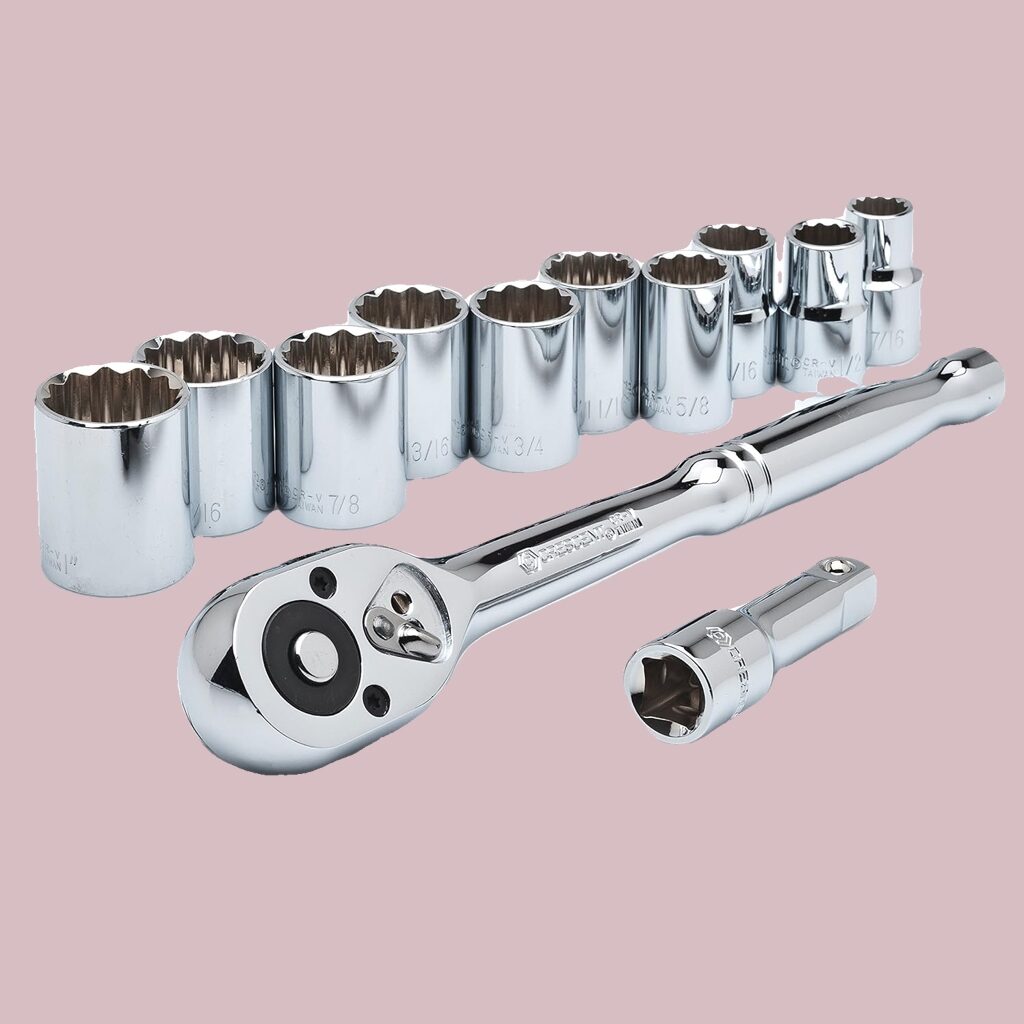
Socket wrenches have a variety of applications in automotive repair, machinery maintenance, and other mechanical work. Their ability to access fasteners in tight and hard-to-reach spaces, such as engine compartments and machinery assemblies, makes them indispensable in many professional settings.
Overall, socket wrenches offer mechanics a powerful and versatile tool to tackle a wide range of tasks with efficiency and precision. By understanding the features and applications of socket wrenches, both professionals and DIY enthusiasts can make informed choices when it comes to selecting the right tool for their specific needs.
Box-End Wrenches for High-Torque Applications
When it comes to high-torque applications, box-end wrenches are the go-to tool for mechanics. Designed specifically for tasks that require a significant amount of force, these wrenches excel in delivering the power needed to tackle stubborn and tightly fastened components.
Now, let’s compare the features of box-end and open-end wrenches, and understand why box-end wrenches are preferred in certain situations.
Comparing Box-End and Open-End Wrenches
Both box-end and open-end wrenches serve their purpose in various mechanical tasks, but they differ in their design and functionality.
Box-end wrenches, also known as closed-end wrenches, feature a closed loop on one or both ends, enclosing the fastener completely. This design provides a snug fit and offers more points of contact with the fastener, minimizing the risk of slipping or rounding off the edges.
On the other hand, open-end wrenches have U-shaped jaws that grip onto the two opposite flats of the fastener. While open-end wrenches are versatile and allow convenient access to fasteners in tight spaces, they may not provide the same level of torque transfer as box-end wrenches.
Why Box-End Wrenches Are Preferred for Stuck Fasteners
One specific scenario where box-end wrenches shine is when dealing with stuck or difficult-to-remove fasteners. Due to their enclosed design, box-end wrenches provide more contact with the fastener, maximizing the grip and minimizing the chance of slippage.
When you encounter a stuck fastener, the closed loop of the box-end wrench can provide the necessary leverage and torque to break it free, even in challenging conditions. The tight fit of the box-end wrench reduces the risk of rounding off the fastener, ensuring that it remains intact and reusable.
Whether you’re working on automotive repairs, plumbing installations, or any task that requires high torque, having a set of box-end wrenches in your toolkit is essential for tackling those demanding applications.
Now that we’ve explored the advantages of box-end wrenches, let’s move on to the next section, where we will unravel the features and uses of specialty wrenches.
Specialty Wrenches: A Look at Less Common Variants
While the standard wrenches cover a wide range of applications, there are specialized wrenches designed for specific tasks. In this section, we will take a closer look at less common types of wrenches that can come in handy for unique mechanical challenges.
One example of a specialty wrench is the crowfoot wrench. This unique tool features a wrench head in the shape of a crow’s foot, allowing it to fit into tight spaces where conventional wrenches cannot reach. Crowfoot wrenches are commonly used in automotive and plumbing applications.
Another less common type of wrench is the dog bone wrench. This compact wrench resembles a dog bone shape, with multiple sizes of sockets on each end. Dog bone wrenches are versatile and can be adjusted to fit various fastener sizes, making them a convenient choice for quick repairs on the go.
Tap wrenches are specifically designed for tapping operations in metalworking. They provide a secure grip on tap handles, allowing precise control and preventing slippage during the tapping process.
Strap wrenches, on the other hand, utilize a flexible strap instead of a solid wrench head. This design makes them ideal for gripping odd-shaped objects and delicate surfaces without causing damage.
By familiarizing ourselves with these specialty wrenches and their unique features, we can expand our knowledge and be prepared to tackle a wider range of mechanical challenges.
Exploring the Precision of Torque Wrenches
Beam-Style vs. Click-Style Torque Wrenches
Torque wrenches are essential tools for achieving precise torque application, especially in critical mechanical assemblies. These specialized wrenches allow mechanics to apply a specific force to fasteners, ensuring optimal performance and safety. In this section, we will delve into the different types of torque wrenches, namely beam-style and click-style variants, and examine their unique features and applications.
Beam-style torque wrenches utilize a simple, yet effective design. They consist of a long lever arm with a marked beam that bends when torque is applied. By reading the scale on the beam, mechanics can determine the applied torque. Beam-style torque wrenches are known for their durability, as they don’t contain complex internal mechanisms that can wear out over time. However, they require careful observation of torque readings, as there is no audible or tactile feedback to indicate when the desired torque is reached.
“Beam-style torque wrenches provide a reliable and cost-effective solution for precise torque application, especially in applications where the desired torque can be visually monitored,” says John Gibson, a seasoned mechanic with over 20 years of experience in the automotive industry.
On the other hand, click-style torque wrenches offer a more user-friendly experience with audible and tactile cues. These wrenches feature an internal mechanism that produces a click sound and a slight release of tension when the desired torque is reached. This provides mechanics with clear feedback, allowing for accurate and consistent torque application. Click-style torque wrenches are available in various designs, ranging from micrometer-style to digital models, offering different levels of precision and convenience.
It is crucial to select the right type of torque wrench for each task, considering factors such as the required torque range, the desired level of precision, and personal preferences. Both beam-style and click-style torque wrenches have their advantages and considerations, depending on the specific application.
Ensuring Accurate Torque Application with the Right Wrench
Accurate torque application is critical to ensure the integrity and reliability of mechanical assemblies. Using the appropriate torque wrench for each task is essential to achieve precise torque values and prevent under or over-tightening of fasteners. When selecting a torque wrench, consider the following factors:
- The required torque range: Choose a torque wrench that covers the desired torque range for the specific application.
- Type of fasteners: Different types of fasteners may require torque wrenches with specific features, such as different drive sizes or specialized adapters.
- The level of precision: Consider the level of accuracy required for the task. Beam-style torque wrenches may be suitable for applications where rough torque values are acceptable, while click-style wrenches offer more precise torque measurements.
- User comfort and ease of use: Ensure that the chosen torque wrench is comfortable to handle and easy to operate. This can help prevent user fatigue and promote accurate torque application.
- Regular calibration: Torque wrenches should be regularly calibrated according to the manufacturer’s recommendations or industry standards to maintain accuracy.
By using the right torque wrench and following proper torque application techniques, mechanics can achieve accurate and consistent torque values, leading to improved performance and reliability of mechanical systems.

Wrench Selection: Matching Tasks with the Right Tool
Choosing the right wrench for a specific task is essential to optimize efficiency and achieve quality results. As mechanics, understanding the factors to consider when selecting a wrench can make all the difference in the effectiveness of our work. Let’s explore these crucial considerations:
Factors to Consider When Choosing a Wrench
- The Task at Hand: Assess the specific requirements of the task, such as the size of the fastener and the type of material you are working with. Different wrenches are designed for various applications, so matching the right tool to the task is essential for optimal performance.
- Wrench Size: Ensure that the wrench you select is the appropriate size for the fastener you need to tighten or loosen. Using a wrench that is too small or too large can result in inefficient work and potential damage to the fastener.
- Wrench Type: Consider the specific type of wrench that best suits the task. There are various types of wrenches available, each with its advantages and limitations. For example, open-end wrenches are suitable for tight spaces, while socket wrenches offer versatility with their interchangeable sockets.
- Material and Quality: Pay attention to the material and construction quality of the wrench. High-quality wrenches made from durable materials like chrome vanadium steel ensure longevity and reliability in demanding work environments.
How Wrench Type Affects Mechanic’s Efficiency
The selection of the right wrench type directly impacts a mechanic’s overall efficiency and productivity. Using the appropriate wrench type for the task at hand saves time, and effort, and reduces the risk of causing damage. It allows for smoother and more accurate tightening or loosening of fasteners, leading to improved efficiency in completing mechanical tasks.
By carefully evaluating the factors mentioned above and selecting the right wrench, mechanics can enhance their overall performance and achieve optimal results. Let’s move forward to the next section and explore the advanced applications of impact wrenches.
Tackling Advanced Applications with Impact Wrenches
When it comes to advanced applications that require high torque and speed, impact wrenches are the ultimate tool of choice. These powerful and efficient tools are designed to deliver exceptional performance and productivity in various mechanical tasks. In this section, we will delve into the features and applications of impact wrenches, highlighting their benefits and demonstrating why they are essential for tackling more challenging projects.
An impact wrench, also known as an air wrench or pneumatic wrench, is a specialized tool that utilizes rotational force to generate high torque. Its unique mechanism allows for quick and efficient tightening or loosening of fasteners, significantly reducing the time and effort required compared to manual wrenches.
Features of Impact Wrenches:
- Powerful Torque: Impact wrenches are known for their exceptional torque output, making them ideal for heavy-duty applications where high force is required to overcome resistance.
- Quick and Easy Operation: These wrenches offer rapid rotation, enabling fast tightening or loosening of bolts and nuts. They are specifically designed to save time, making them indispensable in professional settings.
- Diverse Power Sources: Impact wrenches are available in various power options, including pneumatic (air-powered), electric, and cordless battery-powered models. This versatility allows users to choose the most suitable power source based on their specific needs and preferences.
- Ergonomic Design: Impact wrenches are designed with user comfort in mind, featuring ergonomic grips and handles that reduce fatigue during extended use. This ergonomic design enhances the overall efficiency and productivity of mechanics.
Applications of Impact Wrenches:
Impact wrenches find extensive use in a wide range of advanced mechanical applications, including but not limited to:
- Automotive Repair: Impact wrenches are indispensable in automotive repair and maintenance tasks, such as removing and installing lug nuts, suspension components, and engine fasteners.
- Construction and Building: Impact wrenches are essential for construction and building projects, facilitating quick and accurate installation of structural bolts, scaffolding, and large-scale fastenings.
- Industrial Machinery: These versatile tools are commonly utilized in industrial settings for the assembly and disassembly of machinery, equipment, and heavy-duty components.
- Large-scale Projects: Impact wrenches are often employed in large-scale projects, including bridge construction, shipbuilding, and infrastructure development, due to their ability to deliver high torque and handle demanding tasks.
By understanding the capabilities and applications of impact wrenches, mechanics can confidently tackle advanced projects that demand precise and efficient fastening. The power and versatility of impact wrenches empower professionals to achieve superior results and maximize productivity in their mechanical work.
Conclusion
In conclusion, mastering the knowledge of different types of wrenches and their applications is essential for any mechanic or DIY enthusiast. Understanding the functionality and importance of wrenches, as well as their design and leveraging, allows for efficient and effective mechanical work.
Building a complete wrench set that covers a range of sizes and types can greatly enhance efficiency and versatility in various tasks. With the right wrenches, mechanics can tackle a wide range of applications with confidence and ease.
Additionally, maximizing the lifespan and usability of wrenches is crucial in prolonging their effectiveness and maintaining their performance. Taking proper care and maintenance measures, such as cleaning and lubricating the wrenches regularly, can help prevent rust and ensure smooth operation for years to come.
FAQ
Q: What are the different types of wrenches?
A: There are various types of wrenches, including open-end wrenches, combination wrenches, adjustable wrenches (also known as crescent wrenches), socket wrenches, box-end wrenches, and specialty wrenches like crowfoot wrenches, dog bone wrenches, tap wrenches, and strap wrenches.
Q: What is the functionality and importance of wrenches in mechanical work?
A: Wrenches are essential tools in mechanics as they allow for the gripping and turning of nuts, bolts, and fittings. They provide leverage and apply torque, enabling the loosening or tightening of fasteners. Wrenches are crucial for efficient and effective mechanical work.
Q: How do open-end wrenches work and when should I use them?
A: Open-end wrenches have a U-shaped opening on each end and are versatile and easy to use. They are suitable for many situations but have limitations due to their design. Open-end wrenches are best used when access is limited, and the wrench needs to be quickly flipped for different sizes of nuts or bolts.
Q: What are combination wrenches, and how can they be beneficial?
A: Combination wrenches have an open-end wrench on one end and a closed-end wrench on the other. This design offers versatility and makes them useful for tackling different sizes of nuts and bolts. Combination wrenches are a must-have tool for any mechanic or DIY enthusiast.
Q: What are adjustable wrenches, and when should I use them?
A: Adjustable wrenches, also known as crescent wrenches, have jaws that can be adjusted to fit a range of fastener sizes. They are versatile tools and are useful when you have limited space or need to work with various sized nuts or bolts.
Q: What are socket wrenches, and why are they favored by mechanics?
A: Socket wrenches are highly favored by mechanics due to their efficiency and versatility. They consist of a handle and detachable sockets of different sizes that can fit various nuts and bolts. Socket wrenches allow for quick and easy fastener changes, making them a preferred choice in mechanical work.
Q: What are box-end wrenches, and why are they useful for high-torque applications?
A: Box-end wrenches have a closed-end with six or twelve points and are specifically designed for high-torque applications. They provide a secure grip on fasteners and prevent rounding. Box-end wrenches are preferred when dealing with stuck or stubborn fasteners.
Q: Are there any specialty wrenches available for unique tasks?
A: Yes, there are specialty wrenches designed for specific tasks. Some examples include crowfoot wrenches, dog bone wrenches, tap wrenches, and strap wrenches. These specialty wrenches offer unique features and are useful for tackling unique mechanical challenges.
Q: What are torque wrenches, and why are they important?
A: Torque wrenches are essential for precise torque application, especially in critical mechanical assemblies. They come in different types, including beam-style and click-style torque wrenches. Using the right torque wrench ensures accurate torque application and helps prevent over-tightening or under-tightening of fasteners.
Q: What factors should I consider when choosing a wrench?
A: When choosing a wrench, you should consider factors such as wrench size, type, and material. The size of the wrench should match the fastener size, and the type of wrench should be suitable for the task at hand. The material should be durable and provide a secure grip.
Q: What are impact wrenches, and when should I use them?
A: Impact wrenches are high-torque tools used for advanced applications that require high torque and speed. They are commonly used in automotive and construction industries. Impact wrenches are beneficial for quickly loosening or tightening stubborn fasteners.
Q: How can I build a complete wrench set for my toolkit?
A: Building a complete wrench set involves selecting wrenches of different types and sizes to accommodate various tasks. It is essential to have a range of open-end wrenches, combination wrenches, adjustable wrenches, socket wrenches, and specialty wrenches. Adding high-quality, durable wrenches to your toolkit will ensure versatility and efficiency.
Q: What maintenance measures should I take to maximize the lifespan of my wrenches?
A: To maximize the lifespan of your wrenches, you should regularly clean them after use, apply lubrication to moving parts, and store them in a dry, well-ventilated area. Avoid exposing wrenches to excessive heat or direct sunlight, as it can affect their performance and durability.


